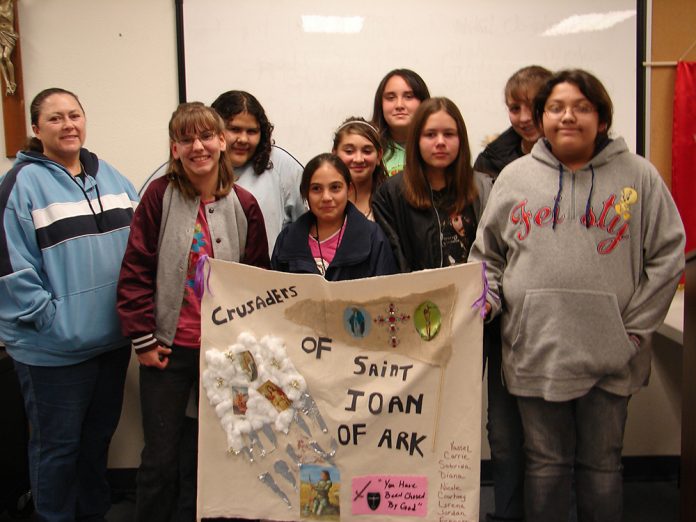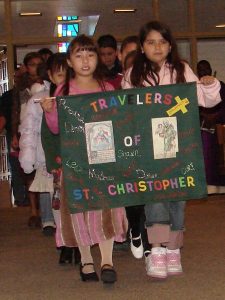
Grow Catholic identity
THERESE L. SALAZAR
Most of our students come to us after they have been in class all day learning academics. The last thing they want is to have another class. How can we make our faith formation programs and classes different from school? How can we make them feel that they are coming to a special place for a special time? One way is to take on a yearly theme for our program and have each class take a class name based on that theme.
 By using this method, we give our program and individual classes a Catholic identity. Our students are not just the fourth grade faith formation class; they are the “Jewels of Mary, Virgin Most Prudent” or the “Scholars of St. Jerome.” With this identity, the class becomes a sodality or club. This gives a different importance to the class. It is not just another class they have to attend; this is a special club.
By using this method, we give our program and individual classes a Catholic identity. Our students are not just the fourth grade faith formation class; they are the “Jewels of Mary, Virgin Most Prudent” or the “Scholars of St. Jerome.” With this identity, the class becomes a sodality or club. This gives a different importance to the class. It is not just another class they have to attend; this is a special club.
The room can be decorated to reflect the class name; a banner could be created and hung on the wall. The banner might have pictures of the students and symbols of their saint. The class could have a special prayer they recite.
The theme and class names can be used to teach the topic on a deeper level. If a particular saint is chosen, the class could learn the history of the saint and why he or she was declared a saint, and they could be encouraged to be holy in imitation of their class patron. The litanies could be springboards for discussion on what they mean and why they pertain to Jesus, Mary, or the saints. The litanies could also become words for meditation and prayer. Here’s how it works.
First the catechetical leader chooses a theme for the year. Some themes might be:
■ God the Father
■ God the Son
■ God the Holy Spirit
■ Mary
■ Approved Marian Apparitions
■ Saints of the Early Church
■ Saints of the Middle Ages
■ Recent Saints
■ Young Saints
■ Find more at CatholicSaints.info
The leader then finds a litany for that theme and chooses more than enough lines for each catechist to choose one line each. An internet search can be very helpful for this, and links are provided for each of the litany samples that follow.
LITANY OF GOD THE FATHER:
Father, most holy,
Father, our defender,
Father, our light,
Father, our joy and glory,
Father, guide of youth.
LITANY OF LORETO:
Mother of Christ,
Mother most chaste,
Virgin most prudent,
Cause of our joy,
Mystical Rose.
LITANY OF ST. JOSEPH:
Foster-father of the Son of God,
Joseph most chaste,
Joseph most obedient,
Guardian of virgins,
Pillar of families,
Terror of demons.
Next, the leader gives each catechist the theme, the list of litany lines, and maybe a list of suggested class names. Examples of a class name could be:
■ Believers of …
■ Lambs of …
■ Sportsmen of …
■ Tulips of …
■ Flames of …
Finally, using these lists, each catechist then chooses a class name and pairs it with a line from the litany to create a unique name for his or her class. This becomes their identity for the year. They are referred to and can be listed in your records by this name. You might have:
■ Sparks of God the Father, Our Light
■ Roses of Mary, Mystical Rose
■ Knights of St. Joseph, Terror of Demons
Once a class name is created the catechists in collaboration with their students make a banner with their class name and hang it in their classroom. We usually have three or four banners in each room because the room is used by different classes during the week. To download an extensive list of suggested class names, click on this link: Suggested Class Names-1
For our annual Faith Formation Corporate Mass, the children process into the church as a class carrying their banner just before Mass begins. They are introduced to the parish using their class name.
The themes and class names are unlimited. The various litanies of the Church, Mary, and the Saints are a wonderful source and typically have many lines to accommodate both small and large programs.
After using this idea for many years, we have found that the catechists and students are excited to learn what the new theme will be and are eager to choose a class name. Many students fondly recall their class identity from earlier years.
THERESE L. SALAZAR, MA, teaches sixth, seventh, and eighth grade religion classes at St. Mary’s School in Belen, New Mexico. She is an active wife, mother, and grandmother, recently retired as director of religious education from Our Lady of Belen Church, Belen, New Mexico.
PHOTOS COURTESY OF THERESE L. SALAZAR
This article was originally published in Catechist, April-May 2020.




